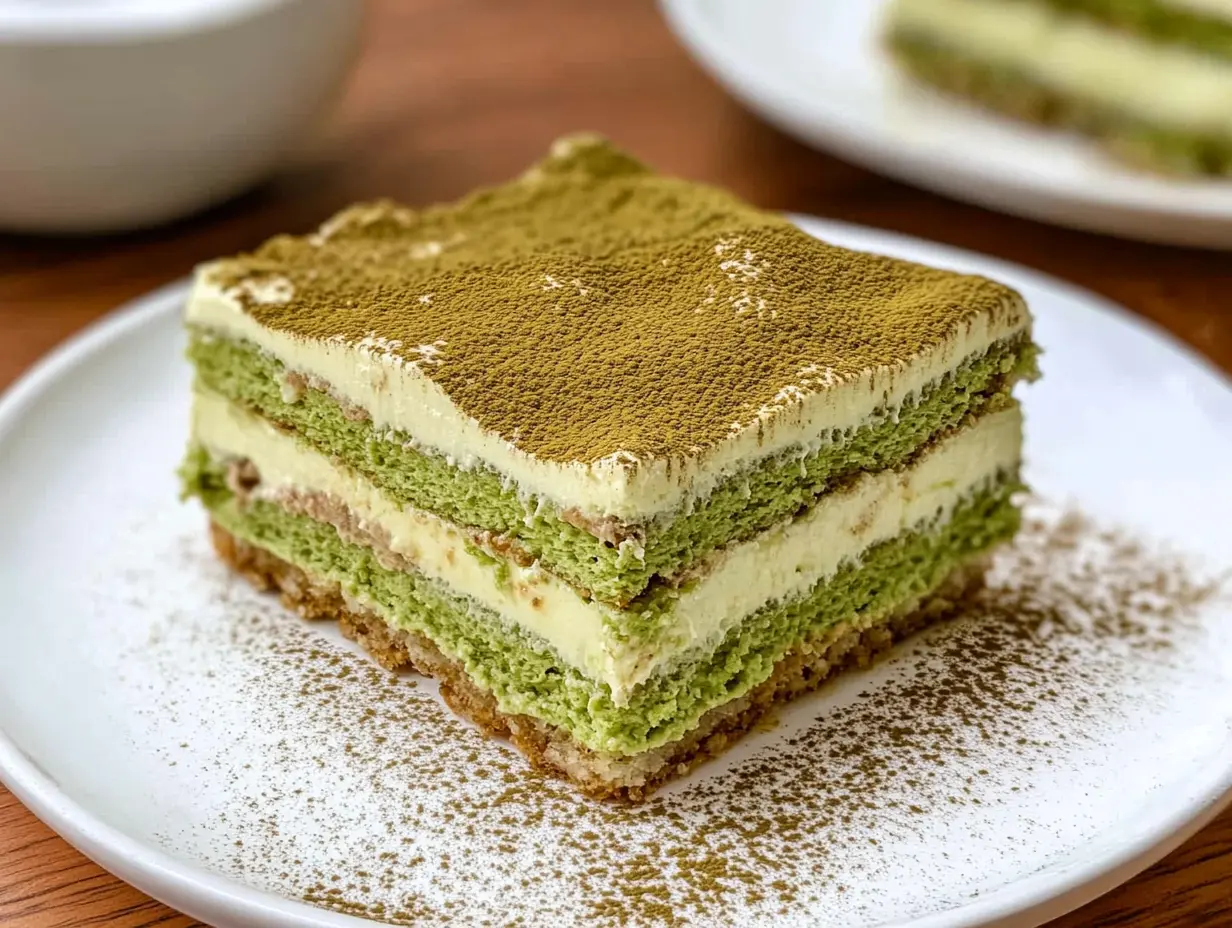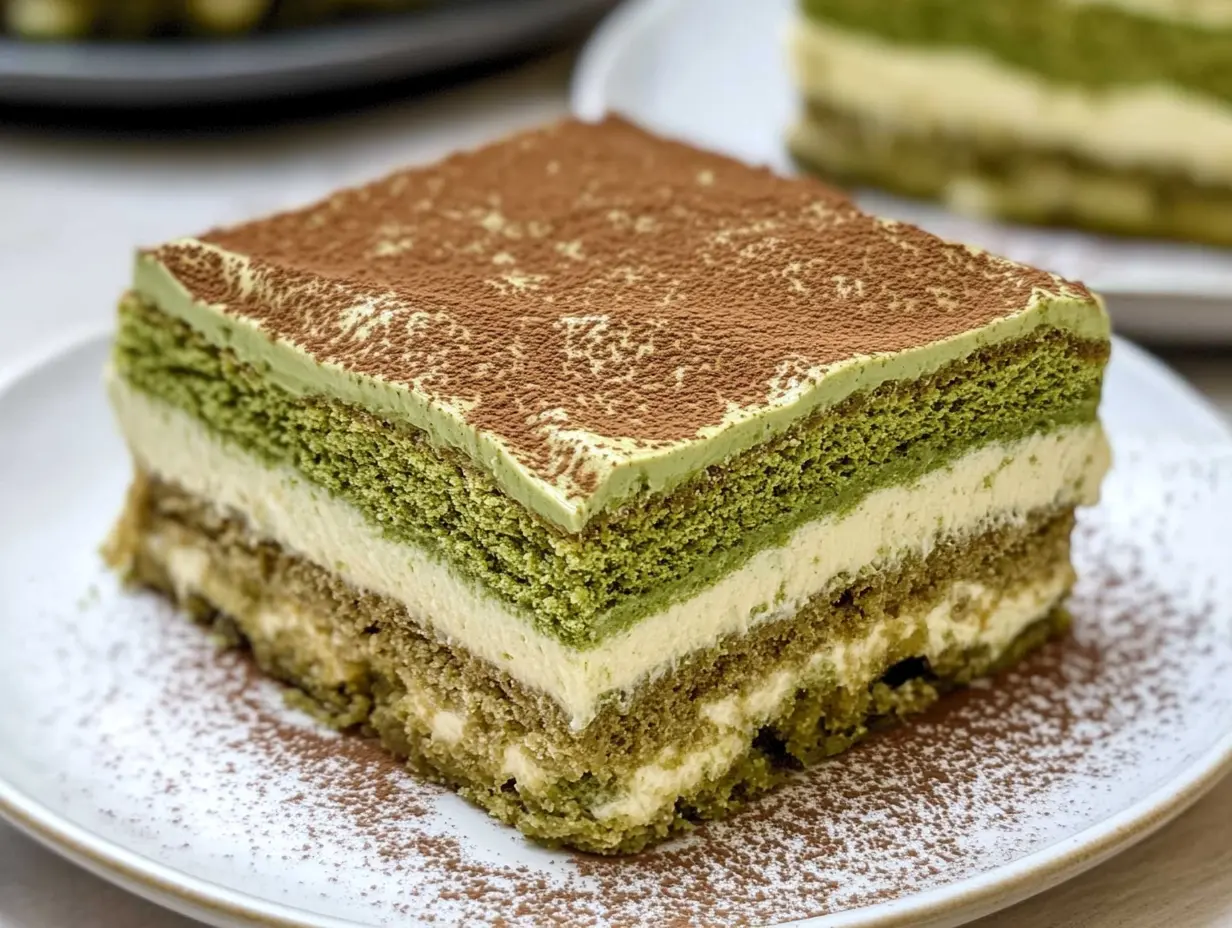When you think of tiramisu, the rich layers of coffee-soaked ladyfingers and creamy mascarpone filling come to mind. Now, imagine infusing that classic Italian dessert with the vibrant flavors of matcha, the finely ground green tea powder from Japan. Welcome to the world of matcha tiramisu, where East meets West in a delightful fusion of flavors.
The Origins of Tiramisu and Matcha
The history of tiramisu is as rich as the dessert itself. Originating in Italy, this iconic dish first appeared in the region of Veneto in the 1960s. While the precise origins remain disputed, many agree that tiramisu became popular thanks to its simple yet decadent ingredients: layers of espresso-soaked ladyfingers, mascarpone cheese, and a dusting of cocoa powder. The name “tiramisu” itself means “pick me up,” referencing both the dessert’s indulgent flavors and the energy-boosting properties of the espresso it contains. Tiramisu quickly became a household favorite in Italy and later gained global recognition as one of the most popular Italian desserts.
While tiramisu was evolving in Italy, matcha had already been a staple in Japanese culture for centuries. Derived from green tea leaves, matcha is finely ground into a powder and is often used in traditional tea ceremonies. Its vibrant green color, coupled with its slightly bitter and earthy flavor, makes it a unique addition to both beverages and desserts. Matcha is also celebrated for its many health benefits, including high levels of antioxidants and a more sustained energy boost than coffee. Over the last few decades, matcha has made its way into Western kitchens, where chefs have begun to incorporate it into dishes like lattes, cakes, and now, tiramisu. Curious about tiramisu’s history? You can explore more about its origins here.
By blending these two culinary traditions, we get matcha tiramisu—a delicious fusion of flavors that perfectly balances the richness of mascarpone with the earthy bitterness of matcha. It’s no wonder that this fusion dessert has gained popularity among food lovers looking to experiment with new and exciting combinations.
Why Choose Matcha Tiramisu?
There are many reasons to choose matcha tiramisu over the traditional version, starting with its unique flavor profile. Traditional tiramisu, with its layers of espresso and mascarpone, offers a rich, coffee-forward taste. However, replacing the espresso with matcha creates a completely new experience. Matcha’s slightly bitter and earthy tones add complexity to the dessert, balancing out the creaminess of the mascarpone and the sweetness of the ladyfingers. This fusion of flavors gives matcha tiramisu an elegance that appeals to those who enjoy desserts with a more refined taste.
Additionally, matcha is packed with health benefits. Unlike espresso, which can give you a quick caffeine jolt followed by a crash, matcha offers a more sustained and balanced energy boost. This is because matcha contains L-theanine, an amino acid that promotes relaxation and focus without the jittery side effects associated with coffee. Matcha is also rich in antioxidants, particularly catechins, which are known to promote heart health, support weight loss, and provide anti-aging benefits. This makes matcha tiramisu not only a delicious treat but also a more health-conscious choice. If you’re curious about the health benefits of matcha, you can learn more about them here.
For those who love fusion cuisine, matcha tiramisu is the perfect blend of Italian and Japanese flavors. It’s a dessert that surprises the palate, making it ideal for special occasions or even as an everyday indulgence. Whether you’re new to matcha or a seasoned fan of the vibrant green tea powder, this dessert will offer you a delightful twist on a classic favorite.
Ingredients for Matcha Tiramisu
Making matcha tiramisu requires a blend of traditional ingredients and a few key additions to incorporate the matcha flavor. Here’s a breakdown of what you’ll need to create this fusion dessert:
- Ladyfingers: These sponge-like cookies are a staple in tiramisu. They soak up the matcha mixture, providing a soft yet firm base for the layers. Store-bought ladyfingers work perfectly, but you can also make them from scratch if you prefer.
- Mascarpone Cheese: This Italian cream cheese is essential for the rich, creamy texture of tiramisu. Make sure to use high-quality mascarpone for the best results.
- Egg Yolks: These provide richness and help bind the mascarpone mixture. Make sure the yolks are fresh and pasteurized.
- Egg Whites: Whipping the egg whites until stiff peaks form helps lighten the mascarpone mixture, giving the dessert a fluffy texture.
- Sugar: Granulated sugar is used to sweeten both the mascarpone layer and the matcha mixture.
- Heavy Cream: This adds extra creaminess to the mascarpone layer and helps create a silky smooth texture.
- Matcha Powder: The star of the show! Make sure to use high-quality culinary or ceremonial grade matcha. Culinary matcha works best for desserts due to its stronger flavor, while ceremonial matcha is typically reserved for drinking. You can find out more about the difference between these two grades here.
- Vanilla Extract: Adds a subtle sweetness and depth to the mascarpone mixture.
- Hot Water: Used to dissolve the matcha powder and create a concentrated matcha tea for soaking the ladyfingers.
How to Make Matcha Tiramisu: Step-by-Step Instructions
Making matcha tiramisu at home might seem intimidating, but with the right guidance, you’ll find it’s simpler than you think. This no-bake dessert requires just a bit of patience and careful layering to achieve the perfect texture and flavor. Here’s a detailed breakdown of how to make this delightful fusion dessert:
Preparing the Components
- Prepare the Matcha Mixture: Start by dissolving 2-3 tablespoons of matcha powder in about ½ cup of hot water. Whisk until fully dissolved and no clumps remain, then let it cool to room temperature. The quality of your matcha is crucial here—opt for culinary-grade matcha for a strong, vibrant flavor. If you use ceremonial grade, the flavor will be milder, which might not shine through as well in a dessert.
- Make the Mascarpone Mixture: In a large mixing bowl, whisk together 4 egg yolks and ½ cup of granulated sugar until the mixture is pale and fluffy. This step is essential for achieving the rich, creamy consistency typical of tiramisu. Once smooth, add 16 ounces of mascarpone cheese and 1 teaspoon of vanilla extract, continuing to whisk until everything is well combined. The mascarpone should be at room temperature to avoid any lumps in the mixture.
- Whip the Egg Whites and Cream: In a separate bowl, whip 4 egg whites until stiff peaks form. In another bowl, whip 1 cup of heavy cream until soft peaks form. Gently fold both the whipped egg whites and whipped cream into the mascarpone mixture. This step adds airiness to the dessert, creating that light, fluffy texture tiramisu is known for.
Assembling the Layers
- Soak the Ladyfingers: Take each ladyfinger and dip it into the cooled matcha mixture. Be careful not to oversaturate them, as the ladyfingers can become too soggy if left in the matcha for too long. A quick dip—about 1-2 seconds on each side—should be enough to absorb the flavor without compromising the texture.
- Layer the Tiramisu: In a rectangular dish or individual serving cups, start by placing a layer of matcha-soaked ladyfingers on the bottom. Next, spoon a layer of the mascarpone mixture over the ladyfingers. Repeat the process, alternating between ladyfingers and mascarpone until the dish is filled. Typically, you’ll have 2-3 layers, depending on the size of your dish.
- Refrigerate and Garnish: Cover the dish with plastic wrap and refrigerate for at least 4 hours, but overnight is best to allow the flavors to meld together. When ready to serve, dust the top with extra matcha powder for an added touch of flavor and visual appeal. If you want to add a bit more sweetness, you can also garnish with white chocolate shavings.
Variations of Matcha Tiramisu
One of the best aspects of matcha tiramisu is its versatility. Whether you’re catering to dietary restrictions or simply looking for a creative twist, there are many ways to adapt this recipe to suit your needs:
- Vegan Matcha Tiramisu: For a dairy-free and egg-free version, swap out the mascarpone cheese with a vegan alternative, such as cashew cream or dairy-free cream cheese. You can replace the egg yolks with a vegan egg substitute, like flax eggs or aquafaba (the liquid from canned chickpeas), and use coconut whipped cream in place of the heavy cream. Ladyfingers can also be substituted with vegan cookies or biscuits.
- Gluten-Free Matcha Tiramisu: If you or your guests are gluten intolerant, you can easily make this dessert gluten-free by using gluten-free ladyfingers or homemade gluten-free sponge cake. Just be mindful of the ingredients in your mascarpone and matcha powder to ensure they’re gluten-free as well.
- Matcha Tiramisu Cups: For a more elegant presentation or smaller servings, try making individual matcha tiramisu cups. Simply follow the recipe but layer the ingredients in small glasses, jars, or bowls. These are perfect for parties or events where individual servings make it easier for guests to enjoy.
- Flavored Variations: You can experiment with additional flavors by adding ingredients like white chocolate to the mascarpone mixture or incorporating a splash of matcha liqueur into the soaking liquid for the ladyfingers. This can elevate the flavor profile and make the dessert even more unique.
Tips for the Best Matcha Tiramisu
Creating the perfect matcha tiramisu isn’t just about following the steps—there are a few tips that can help take your dessert to the next level:
- Use High-Quality Matcha: The flavor of matcha varies greatly depending on the grade and quality. For desserts, it’s recommended to use culinary-grade matcha, as it has a bolder flavor. However, if you prefer a more subtle taste, you can opt for ceremonial-grade matcha. Remember, the quality of matcha directly impacts the color and flavor of your tiramisu.
- Avoid Over-Soaking the Ladyfingers: It’s easy to over-soak the ladyfingers, which can result in a soggy, unpleasant texture. A quick dip in the matcha mixture is all you need to achieve the perfect consistency.
- Chill for the Right Amount of Time: Letting your tiramisu chill for at least 4 hours is crucial for allowing the flavors to blend together. If possible, refrigerate the dessert overnight. This will also ensure the layers firm up and hold their shape when sliced or served.
- Sift the Matcha Powder: Before adding matcha to your dessert, make sure to sift it to remove any lumps. This ensures a smooth and even texture in the matcha mixture and when dusting the final product.
Nutritional Benefits and Considerations
Matcha tiramisu is a decadent dessert, but it comes with some nutritional benefits thanks to the addition of matcha. Here are a few things to keep in mind:
- Antioxidants: Matcha is packed with antioxidants, particularly catechins, which are known to have various health benefits such as supporting heart health and boosting metabolism. This makes matcha tiramisu a slightly healthier choice compared to traditional coffee-based tiramisu.
- Caffeine Levels: While matcha does contain caffeine, it provides a more balanced and sustained energy boost compared to coffee. The combination of caffeine and L-theanine in matcha helps promote focus and relaxation without the jitters typically associated with coffee.
- Calories and Portion Control: Like traditional tiramisu, matcha tiramisu is still a rich and calorie-dense dessert. However, you can control the calorie count by adjusting the portion size and reducing the amount of sugar or cream in the recipe. If you’re watching your sugar intake, consider using a sugar substitute like stevia.
- Healthier Substitutions: For a lighter version, you can use low-fat mascarpone or swap the sugar for a natural sweetener like honey or maple syrup. These small tweaks can make the dessert a bit more guilt-free while still retaining its delicious flavor.
FAQs on Matcha Tiramisu
- Can I use regular green tea instead of matcha?
No, regular green tea doesn’t provide the same concentrated flavor or vibrant color as matcha. Matcha is finely ground whole green tea leaves, which gives it a stronger, more complex flavor that is essential to the dessert’s unique taste. - How long does matcha tiramisu last in the fridge?
Matcha tiramisu will last for about 3-4 days in the refrigerator if stored properly in an airtight container. However, the texture may become softer the longer it’s stored, so it’s best enjoyed within the first couple of days. - Can I freeze matcha tiramisu?
Yes, you can freeze matcha tiramisu for up to a month. Wrap it tightly in plastic wrap and aluminum foil to prevent freezer burn. To serve, let it thaw in the refrigerator for several hours or overnight. - What’s the difference between culinary and ceremonial matcha for desserts?
Culinary-grade matcha is more robust and suited for cooking and baking, while ceremonial-grade matcha is intended for traditional tea drinking and has a more delicate flavor. For matcha tiramisu, culinary matcha is generally preferred because it holds up better in the rich layers of the dessert. You can read more about the differences here. - Does matcha powder need to be sifted for baking?
Yes, it’s always a good idea to sift matcha powder before using it in baking or desserts. This ensures a smooth, lump-free consistency and helps the matcha blend evenly into the mascarpone mixture.
Conclusion: Why You Should Try Matcha Tiramisu
In conclusion, matcha tiramisu offers a delightful blend of Japanese matcha and Italian tiramisu, creating a dessert that is both unique and flavorful. The subtle bitterness of matcha perfectly complements the creamy richness of mascarpone, resulting in a harmonious fusion of flavors.
Plus, with various customizable options like vegan or gluten-free versions, you can tailor this recipe to meet any dietary needs. Why settle for ordinary when you can indulge in the extraordinary?
For a deeper dive into the delicious world of tiramisu and to uncover why this classic dessert tastes so good, check out this insightful article.












Leave a Reply